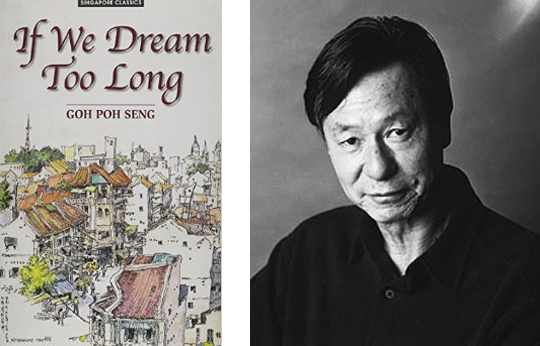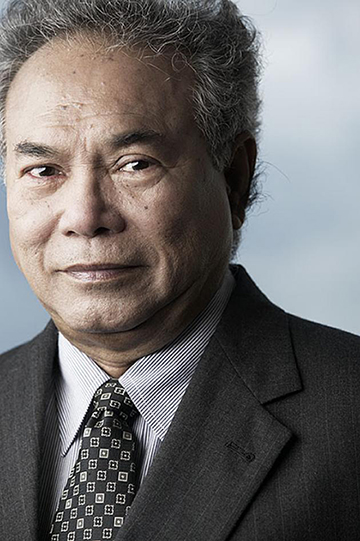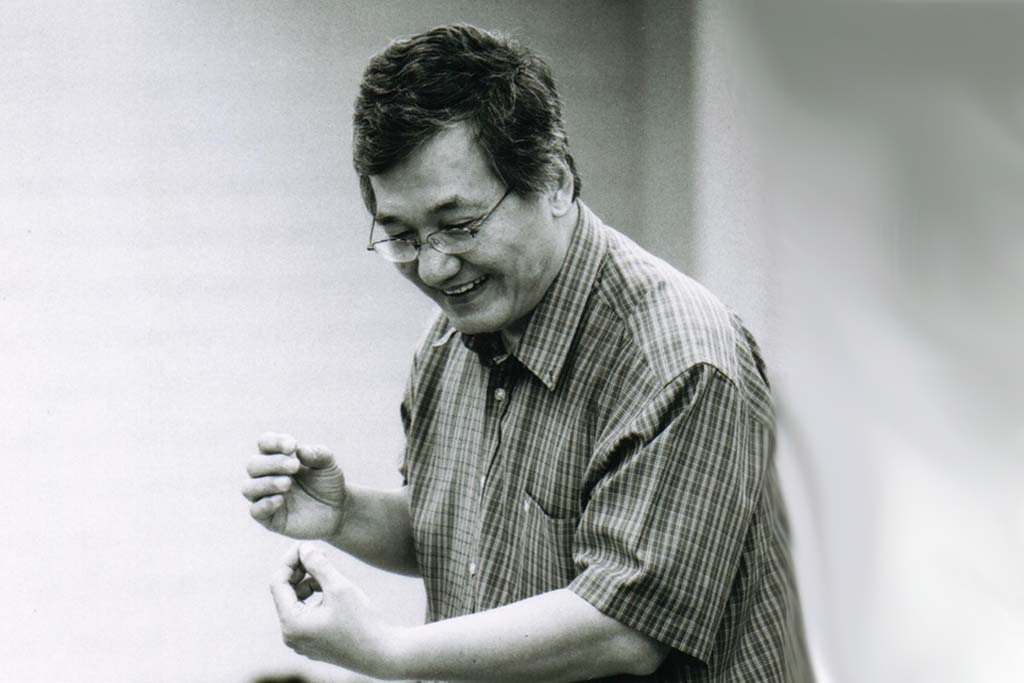LITERATURE ▶
DREAMING OF A MULTICULTURAL SINGAPOREAN LITERATURE
WILLIAM PHUAN
 “I realised that all the books I enjoyed were about somewhere else, not my own hometown. I thought that we needed our own literature in order to know about ourselves,” said the late Singapore pioneer writer Goh Poh Seng about his motivation for writing.1
“I realised that all the books I enjoyed were about somewhere else, not my own hometown. I thought that we needed our own literature in order to know about ourselves,” said the late Singapore pioneer writer Goh Poh Seng about his motivation for writing.1

If we dream too long by Goh Poh Seng, published in 1972, is widely considered to be Singapore's first novel in English.
His first novel, If we dream too long, published in 1972, is widely considered to be Singapore’s first novel in English. It’s been 43 years since Goh Poh Seng’s book came out, and in this 50th year of Singapore’s independence, it may be timely to think about “our own literature”, using Goh’s words, or Singaporean literature.

Professor Edwin Thumboo, in his vision for the role of writers in a multi-racial society, has advocated for more translations.
There have been many attempts over the years to formulate a canon of Singaporean literature. The most notable efforts include the Anthology of ASEAN Literatures: The poetry of Singapore (1985) and The fiction of Singapore (1990), both volumes that are part of the ASEAN anthologies edited by Professor Edwin Thumboo; and Writing Singapore: An historical anthology of Singapore literature (2009), edited by the academics Angelia Poon, Philip Holden and Shirley Geok-lin Lim. Furthermore, Nanyang Technological University has set up a “Singapore literature in English: an annotated bibliography” website, which purports to be the “first such digital bibliography of the entire body of a nation's literature in an official language (meaning English) in Singapore, if not also unprecedented in Southeast Asia.”2
These efforts, seen against Singapore’s policy of multiculturalism and language practice3, bring into sharp relief the challenges of considering Singaporean literature. For one, there is a preponderance of literary works that are written in English. Moreover, there is a lack of concerted translation efforts. While some of these anthologies include English translations of works from Chinese, Malay and Tamil, they are far and few in between, leading the late theatre pioneer Kuo Pao Kun to lament that “for a multiracial nation of such affluence and abundance, there are not even national institutions for translation and publication.”4
Writer and literary critic Gwee Li Sui has also emphasised that we need to include Chinese, Malay and Tamil literary works when we are considering Singaporean literature, and not only English works5.
However, such a holistic consideration is curtailed by a gaping hole of translated works – not only into English, but also Chinese, Malay and Tamil.
The lack of translation thus creates gaps in understanding a Singaporean literature, in which we are not able to know the preoccupations, themes, literary styles, vernacular, and codes in Chinese, Malay and Tamil works. These gaps inadvertently become omissions.
Way back in the 1970s, Thumboo had already advocated for more translation effort. In articulating his idea of “The role of writers in a multi-racial society”6, he stressed the importance of translation as it would help to expand the role of literature beyond the language itself and the ethnic community. He argued that the translation of Singapore Chinese, Malay and Tamil works into a common language, i.e. English, would “serve to make their work available beyond their language community… open possibility of the literature of each language, reflecting not merely the life of its own language community, but also the communities around them.”
As these works become more accessible through translation, they will not only inform the writing of different language writers, but also help to develop a “Singapore writing” that draws on multicultural, multilingual experiences. Thumboo continued: “As the literature in each language enlarges its vision, its view of things to take in the whole of life in Singapore, then we would have reached a point where we have a Singapore writing, in our many languages, but nonetheless very much Singaporean.”
Thumboo’s vision of a Singaporean literature that grows out of a polyglot society and intercultural process of translation is indeed instructive. But ironically, it runs up against a bilingual language policy that has been effectively implemented in Singapore. In 1979, Singapore made English the main official working language and medium of education, while the four ethnic groups (Chinese, Malay, Indian and others) would study their mother tongues as a second language.

Theatre pioneer Kuo Pao Kun said that multiculturalism could lead to more cross-pollination across cultures and languages.
In his famous conceptualisation of “cultural orphan”7, Kuo Pao Kun argued that Singapore’s policies of multiculturalism and language practice have led to a diverse, largely harmonious yet fragmented society. Thus, one result of a deracinated Singapore coupled with the use of English as the main medium is that the ongoing search and formulation of a common culture has been largely articulated through English, a former colonial language, further marginalising the mother tongues.
The bilingual policy has further entrenched the different language writers within their own community, leading to four distinct and separate subsets of a Singaporean literature. The lack of translation has severely limited our access to these works, thereby limiting our understanding of the potential wide spectrum of Singaporean writing. Even though the majority of Singapore’s population is ethnic Chinese (about 70%), most of them are English-educated like Goh Poh Seng, paradoxically turning the Chinese language into a minority language in literary writing.
Indeed, the dominant use of English in modern Singapore literature can be seen in the prominence and proliferation of English language works. In putting together the anthology Writing Singapore, one of the editors Philip Holden defends the book’s decision to include mostly English works with a few translations. He writes: “English in various forms has become the effective lingua franca of Singaporeans moving beyond the space of individual ethnic communities.”8 Furthermore, most Singaporean writers only write in one language, he adds, in spite of our bilingual language policy.
However, a publication like Writing Singapore makes even more pressing the need to undertake a larger project to include works in the other three languages and their translations. For instance, Singapore Malay literature has a long tradition rooted in the Malay Peninsular, and there was much cross-pollination among the writers in Malay-speaking countries like Malaysia, Indonesia, Singapore and Brunei9. In the 1940s and 1950s, Singapore was in fact the centre of publication for newspapers, magazines and books in Malay. The pioneering and influential literary group, Angkatan Sasterawan Lima Puluh or Asas 50 (Literary movement of the 1950s), was established in Singapore in 1950 by a group of progressive writers from Malaysia and Singapore. These writers used literature to tackle social issues and to raise consciousness for independence from the British colonial government. Asas 50 was instrumental in the development of modern Malay literature and language in the region. Yet many of the writers’ works have not been translated.
Furthermore, many pioneer Malay writers in Singapore had already started writing since the 1940s and 1950s, including Harun Aminurrashid, Muhammad Ariff Ahmad (MAS), Mahmud Ahmad, Masuri S. N., and Suratman Markasan. Many of them wrote with a strong social bent, and after Singapore’s independence, they would tackle issues of a multiracial society and how Singapore’s separation from Malaysia impacted the Malay community. However, many of the works that came out of this fertile and formative period of Singapore are still not translated.
In addition, the recently completed Tamil Digital Heritage Collection10 has digitised 350 Tamil literary works by 80 writers, including P. Krishnan, Jayanthi Shankar and KTM Iqbal. The public can now easily access archives of 50 years of local Tamil literature, ranging from published novels to poems and short stories.
Imagine its impact if their English, Chinese and Malay translations are available too, which will allow non-Tamil speaking Singaporeans to delve into this collective heritage and literature.
Without more dedicated and sustained translation effort, Thumboo’s call to expand beyond the language community to achieve a Singaporean writing will still remain a pipe dream almost 40 years on.
Conclusion
The protagonist Kwang Meng in If we dream too long tries to escape from his sense of alienation by immersing himself in books by writers like Hemingway, Dostoyesky, and Graham Greene. It makes one wonder if he could lay his hands on translations of books by Chinese, Malay and Tamil writers then, he would feel a sense of camaderie with other “cultural orphans” who might be experiencing the same angst.
The bilingual language policy has not only reduced the number of works from the mother tongues over the years, but also made their writings more separate and apart from one another. The lack of systematic translation effort further underscores the gaps or omissions in formulating a national literature, while English works remain the dominant mode.
It may be worthwhile in this golden jubilee year to rethink the policy of multiculturalism and language, and to reframe it as one that is intercultural in intent, underlined by a true desire to understand the richness and complexity of each other’s culture and language.
Kuo Pao Kun has said this about multiculturalism: “Biculturally or multiculturally […] the higher you reach into the respective cultures, the more you see all the branches and leaves touching each other. But the stalk, the stem, the trunk are very separated. This is where our level of art is – they are very separated. But if you go deeper, the roots touch. You go higher, the branches touch, the leaves touch. And of course the cross-pollination is done up there. And you absorb the same nutrients, deep underneath. And this is the beauty of multiculturalism.”11
He points to a renewed vision of multiculturalism in Singapore, where we are able to draw on the strengths of our cultural and linguistic diversity to create more works. Through the process of cross-pollination and translation, “our own literature” can grow in ways that our pioneers like Goh Poh Seng and Edwin Thumboo can appreciate, and present readers and writers can be nourished by.
1. Set in 1968, just after Singapore’s independence, If we dream too long follows the young man Kwang Meng, a dreamer who is fresh out of school but too poor to go to university. He finds a job as a low-level clerk, adrift in Singapore with no money and no prospects. Kwang Meng becomes increasingly disenfranchised in a modernising and fast-changing country, tormented by his existential angst. For more information about Goh Poh Seng, please refer to https://www.tribute.sg/artist-profile-goh-poh-seng and https://gohpohseng.wordpress.com.
2. The website is https://eps.ntu.edu.sg/client/SingaporeLiterature.
3. In 1979, the Singapore government imposed a policy that elevated English – a former colonial language – into the first official language, while relegating the mother tongues Chinese, Malay and Tamil into second-language status. English is the main language of instruction in schools, while each ethnic group is required to learn its mother tongue as part of a bilingual effort. The rationale was economic and practical so that Singapore could compete as a developing county and access science, technology and global business.
4. Kuo Pao Kun made this point while formulating his concept of an “open culture”. See “Contemplating an open culture: Transcending multiracialism” in The complete works of Kuo Pao Kun. Volume Seven: Papers and speeches, ed. Chen Min Luan, p. 248 – 257.
5. Gwee Li Sui gave a talk on “Singapore’s literary myths”, as part of the Living with myths series, on 19 August 2015 at the NTU Centre for Comtemporary Art.
6. See Edwin Thumboo’s “The role of writers in a multi-racial society” in Singapore Writing, ed. Chandran Nair, p 5-13.
7. “Cultural orphan” is a term coined by Kuo Pao Kun, who was describing modern Singapore’s dilemma of cultural dislocation. Our forebears from China, India and the Malay archipelago were displaced from their countries when they migrated to Singapore, becoming dislodged and alienated from their mother cultures. Over the decades, many Singaporeans have lost, to various extent, much of their own racial and cultural heritage. As English becomes the de facto national language, it has further alienated them from their mother cultures and mother tongues Chinese, Malay and Tamil, which have been relegated to second language status. The main motivation of Singapore’s multiracialism policy is to contain racial conflict, which consequently stratifies the four main ethnic groups – Chinese, Malay, Indians, and Others – into their own communities instead of integrating them. See “Gu er xin jie, bian yuan xin tai” (in Chinese) in The complete works of Kuo Pao Kun. Volume seven: Papers and speeches, ed. Chen Min Luan, p. 128 – 134.
8. See “General introduction” in Writing Singapore. An historical anthology of Singapore literature, eds. Angelia Poon, Philip Holden and Shirley Geok-lin Lim, p. XXI-XXVI.
9. See “The development of Malay fiction in Singapore” by Masuri S.N. in The fiction of Singapore, general editor Edwin Thumboo, p. 1-23.
10. The collection can be accessed at the National Library Board website, http://eresources.nlb.gov.sg/printheritage/browse/Tamil_Digital_Heritage_Collection.aspx
11. Excerpt from "Between two worlds: A conversation with Kuo Pao Kun" in 9 Lives: 10 years of Singapore Theatre (1987-1997), p. 134-135.





